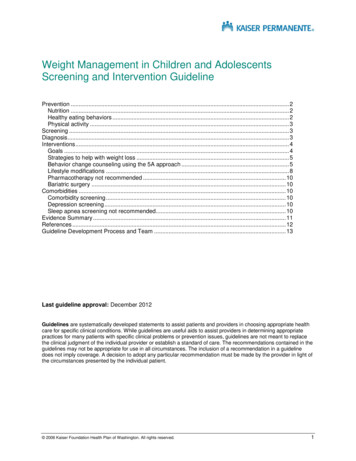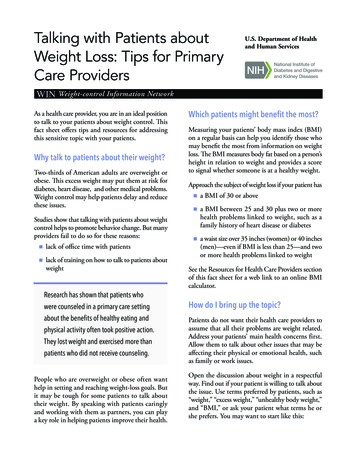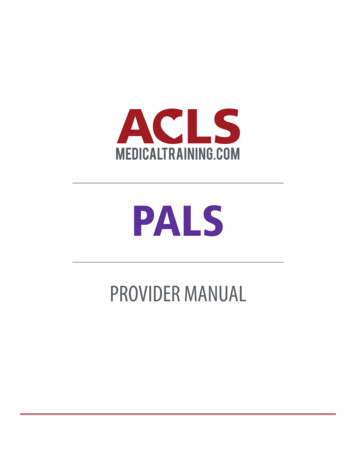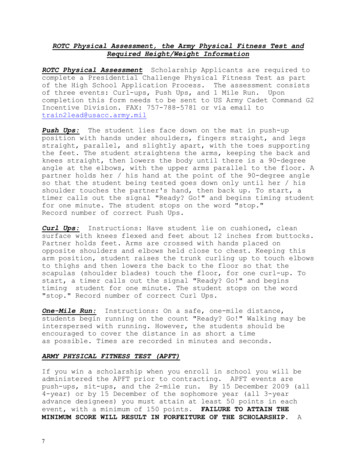
Transcription
Weight Management in Children and AdolescentsScreening and Intervention GuidelinePrevention . 2Nutrition . 2Healthy eating behaviors . 2Physical activity . 3Screening . 3Diagnosis. 3Interventions . 4Goals . 4Strategies to help with weight loss . 5Behavior change counseling using the 5A approach . 5Lifestyle modifications . 8Pharmacotherapy not recommended . 10Bariatric surgery . 10Comorbidities . 10Comorbidity screening . 10Depression screening . 10Sleep apnea screening not recommended. 10Evidence Summary . 11References . 12Guideline Development Process and Team . 13Last guideline approval: December 2012Guidelines are systematically developed statements to assist patients and providers in choosing appropriate healthcare for specific clinical conditions. While guidelines are useful aids to assist providers in determining appropriatepractices for many patients with specific clinical problems or prevention issues, guidelines are not meant to replacethe clinical judgment of the individual provider or establish a standard of care. The recommendations contained in theguidelines may not be appropriate for use in all circumstances. The inclusion of a recommendation in a guidelinedoes not imply coverage. A decision to adopt any particular recommendation must be made by the provider in light ofthe circumstances presented by the individual patient. 2006 Kaiser Foundation Health Plan of Washington. All rights reserved.1
PreventionThe following recommendations for prevention of overweight and obesity in children and adolescents areadapted from the 2010 Scottish Intercollegiate Guidelines Network (SIGN) guideline on managingobesity.Information on nutrition, healthy eating behaviors, and physical activity are also available in patienteducation format. See Parenting Your Child.NutritionBirth to 6 months Breastfeeding is recommended for all infants, until at least 6 months of age. If possible, continueuntil baby is at least 12 months old. (If breast milk is not possible, use formula with iron.) Between 4 and 6 months of age, complementary foods become necessary to support growth,satisfy hunger, and supplement energy and nutrient needs. Solid foods should focus on fruits, vegetables, and iron-rich foods. Introduce lean meats, beans,and legumes at 6 months.6 to 12 months A serving size is the size of the child’s fist; allow the child to decide how much of a food to eat. Consider introducing healthy finger foods around 8 months. Emphasize fruits, vegetables, lean meats, and low-fat dairy products (yogurt and cheese). Limit juice and other sweetened beverages, and encourage plain, unsweetened water to satisfythirst.1 to 3 years A serving size is the size of the child’s fist. Allow the child to decide how much of a food to eat; parents decide when, where, and what tofeed. Allow the child to decide if he/she is hungry and how much to eat at mealtime. Do not “bribe” orpush more foods than the child wants. Children need 3 meals a day, with 1–2 snacks in between. Children aged 12–24 months may be given whole milk or low-fat milk, depending on their growthrate and other dietary intake. Children older than 24 months do not need whole milk; they should be given skim or low-fat milk(1% or 2%). Focus on fruits, vegetables, lean meats, and low-fat dairy products (cheese and yogurt). Limit foods with high fat or sugar content, including fried foods, fast food, and processed foods. Limit juice, sports drinks, soda, and other sweetened beverages. Drink water to satisfy thirst.4 to 17 years Stress the importance of fruits and vegetables at every meal. Encourage breakfast daily. Limit snacking during the day, especially with processed foods. Encourage set times for healthysnacks to discourage grazing. Limit juice, sports drinks, soda, and other sweetened beverages. Drink water to satisfy thirst. Focus on fruits, vegetables, whole grains, lean meats, and low-fat cheeses and yogurt. Limit foods with high fat or sugar content, including fried foods, fast food, and processed foods. If dessert is offered, make it a normal ending to the meal. Do not bribe or reward the child forcleaning his/her plate.Healthy eating behaviors Eat regular family meals, including breakfast, without distractions (e.g., television) when possible.Limit meals eaten outside the home, especially those at fast-food restaurants. When eating out,include fruit and vegetable options.2
Physical activity Engage in 30–60 minutes of moderate- to vigorous-intensity physical activity most days per week,starting at age 6.For children aged 5 and younger, encourage several periods of active play per day.Develop a routine or planned time for active play every day, such as an after-school activity orplay before starting homework.Limit sedentary time (e.g., time spent using computer, playing video games, watching television).ScreeningThe U.S. Preventive Services Task Force (USPSTF) recommends that clinicians screen children aged 6years and older for obesity.Measure height and weight, and calculate BMI percentile at the following frequency: Every visit in primary and consultative care. Every hospital admission.The Centers for Disease Control and Prevention (CDC) website has a BMI percentile calculator forchildren and teens aged 2–19 (http://nccd.cdc.gov/dnpabmi/calculator.aspx). The calculator provides BMIand the corresponding BMI-for-age percentile for girls and for boys.There is insufficient evidence regarding the utility of measuring waist circumference among children andadolescents to predict future health risks.DiagnosisTable 1. Child and adolescent classification of weight by BMI percentileClinical classificationBMI percentileHealthy weight5 –84 percentileOverweight85 –94 percentileObeseAt or above 95 percentile1thth1thththThe BMI percentile indicates the relative position of the child’s BMI number among children of the sameage and gender.There are no routine lab tests recommended for diagnosing obesity. The vast majority of overweight andobesity is due to energy imbalance.It is common for patients and their families to seek out other medical reasons that can occasionally factorin to becoming overweight. We do not recommend routinely testing for such reasons, but we dorecommend a complete history and physical exam for any overweight or obese patient, including furtherevaluation for contributing causes as needed.Contributing causes of overweight and obesity include psychosocial factors (e.g., depression and abuse).Rare causes of weight gain include neuroendocrine disorders (e.g., hypothyroidism, Cushing’s syndrome,hypogonadism, and growth hormone deficiency) and genetic disorders (e.g., Prader-Willi syndrome,Alstrom-Hallgren syndrome, and Carpenter syndrome).3
InterventionsGoalsThe primary goal of any intervention is behavior change that results in healthy eating and regular physicalactivity.Table 2. Recommended goals for children and adolescents12AgeBMI percentileUnder 2yearsCurrent evidence does not suggest any intervention for this age group2–5 years85 –94thNoProlonged weight maintenanceththYesProlonged weight maintenanceNoShared decision making—prolongedweight maintenance or weight lossth95 and higherth95 and higherYesWeight lossththNoShared decision making—prolongedweight maintenance or weight lossththYesWeight lossthNoWeight lossthYesWeight loss85 –9485 –9495 and higher95 and higher12Weight goalth85 –946–17 yearsComorbidityThe BMI percentile indicates the relative position of the child’s BMI number among children of the sameage and gender.Comorbidities include mild hypertension, dyslipidemias, insulin resistance, pseudotumor cerebri, sleepapnea, obesity hypoventilation syndrome, fatty liver, and orthopedic problems.4
Strategies to help with weight lossTable 3. Strategies to help children and adolescents with weight lossBMI percentileth1th85 –94Strategy th95 and higherEngage patient and parent through behavior change counseling (seefollowing section), including addressing family and patient lifestyle. Toaddress childhood obesity effectively, it is important to involve thefamily.Encourage lifestyle modifications, including healthy eating and activeliving (see pages 8–9).Obese children aged 6 years and older should be offered comprehensive,intensive behavioral interventions (USPSTF 2010).There are currently no intensive counseling programs available forchildren at Kaiser Foundation Health Plan of Washington. In thegeographic area served, there may be limited options for older childrenand adolescents (see page 10). In the absence of community programs,we recommend following the same treatment strategy as for children andththadolescents in the 85 –94 percentile.1The BMI percentile indicates the relative position of the child’s BMI number among children of the sameage and gender.Behavior change counseling using the 5A approachTreatment programs for managing childhood overweight and obesity should incorporate behavior changecomponents, be family based—involving at least one parent/caregiver—and aim to change the wholefamily’s lifestyle. Programs should target decreasing overall dietary energy intake, increasing levels ofphysical activity, and decreasing time spent in sedentary behaviors (such as screen time).The use of a behavior change counseling approach such as the 5As may allow clinicians to supportpatients in making changes to eating and physical activity behaviors. The 5As—Ask, Advise, Assess,Assist, Arrange—are an adaptation of motivational interviewing.Depending on the child’s age, these conversations may be with the parent/caregiver or with the olderchild/adolescent. The talking points below give examples for both scenarios.Conversation 1a. AskConversation 1b. AdviseConversation 1c. AssessConversation 1d. AssistConversation 1e. ArrangeConversation 1a. AskAttempt to engage all overweight and obese patients in conversation about their weight.Talkingpoints “Would it be OK if we take a few minutes to talk about your health and weight?”“Has your weight kept you from doing things you wanted to do?”“Do you worry about your son/daughter’s growth or weight?”5
Conversation 1b. AdviseAdvise patients to adopt healthier habits for eating and physical activity, using a clear andpersonalized manner. Avoid loaded terms such as “obese” and “overweight.” Some clinicians referto “healthy weight or growth” and “unhealthy weight or growth.” Frame the discussion aroundmaking healthy changes that can have a number of benefits. Talkingpoints “In the short term, kids who are at an unhealthy weight can sometimes havedifficulties with their peers, feel low self-esteem, be less physically fit, andexperience a lower overall quality of life, compared with those who are at ahealthy weight.”“Kids who are at an unhealthy weight are more likely to develop future chronicconditions, including high blood pressure, high cholesterol, sleep apnea,osteoarthritis, cancer, type 2 diabetes, and liver disease.”“Kids who are at an unhealthy weight are more likely to stay that way as youngadults, compared with those who are at a healthy weight.”“Small changes in eating during childhood, if maintained, can translate to animproved BMI curve into childhood and a better quality of life.”Conversation 1c. AssessDetermine the patient’s willingness to attempt to change lifestyle habits. Also assess the parent’swillingness to make a change in the family’s eating and/or physical activity at this time (i.e., in thenext 30 days). Talkingpoints 1“On a scale of 0 to 10, how ready are you to consider making a healthy changein your eating or physical activity?”1(Scale: 0 not ready 5 unsure 10 ready)“How ready would you say you are to make this [specific change]?”(If high on readiness, 7–10, follow up with the next question.)– “How confident do you feel about making this change?”(This distinguishes those who are ready and confident from those who areready and lacking in confidence. If 6 or lower on readiness scale, considersuggesting a more realistic goal.)“What are the three best reasons to make this change?”“How might you go about it? What would help you succeed?”This scale is completely subjective.6
Conversation 1d. AssistHelp the patient to move along the continuum of readiness to change.TalkingpointsNot ready to change (about 0–3)Leave the door open to further conversations. “Lots of people find it hard to consider making changes to their lifestyle. Thismay not be the right time for you. I'm here to help you, and when you're ready,I’d be happy to talk with you about how you might try to make some changes.” “If you maintain your current weight and avoid further gains, you are taking asuccessful step toward staying healthy.”Unsure about change (about 4–6)Explore ambivalence. “What do you like about the way things are now?” “What don't you like about the way things are now?”Ask about the next step. “What would need to be different for you to feel you are ready to starteating healthier?” “What would need to be different for you to feel you are ready to start beingmore physically active?” “Is there anything you'd like to do between now and our next visit?”Ready to change (about 7–10)Strengthen commitment. “It's great to know that you are ready to change the way that you areeating.” “What are the two most important reasons for you wanting to get moreexercise?”Facilitate action planning. “How might you go about making this change?” “What might get in your way?” “Could you plan around these roadblocks?” “What is your next step?”If patient cannot or does not identify any next steps, try offering some suggestions.(See “Healthy eating and active living” on pages 8–9, under “Lifestylemodifications.”)7
Conversation 1e. ArrangeArrange for follow-up contacts with the patient, either in person or by phone. Also include theSmartPhrase .bmipeds in the after visit summary.TalkingpointsNot ready to change “When you are ready, I am here to support you. I look forward to yournext visit. As part of your well visit care, I will continue to track yourweight and height, and let you know how you are doing.” “Even if you are not ready to make any changes, I’ll plan on checking inwith you about this in the future.”Unsure about change“What information or resources would you be interested in as you considerhealthy eating and getting active?”Ready to change“I am really glad that you are ready to start [walking, eating healthy, etc.].”All patients “Would it be OK if one of my team checked back with you about this inthe next couple of weeks?” “Let me or my team know how you are doing by secure message or byphone, or at your next visit.”Lifestyle modificationsHealthy eating and active livingththChildren and adolescents who are overweight (85 –95 percentile) and especially those who are obeseth(higher than 95 percentile) should be advised to make lifestyle changes that encourage calorie balanceand support normal growth and development without promoting excess weight gain.Every effort should be made not to stigmatize the patient about his/her weight. The focus should be onbehavior change that will promote health.These strategies can help children and adolescents manage their weight.Healthy eating tips Parents are role models and can help to model healthy eating behaviors. Eliminate calories by drinking more water and less soda, fruit juice, and sports and othersugary drinks. Fruit juice is a less healthy choice than fresh fruit, as it adds excess calories without thebenefit of the fiber that is found in fresh fruit. Encourage parents to talk with children and come up with a plan for making healthy foodchoices at school. Stock the house with healthy snacks, including fresh vegetables, fruit, string cheese, andyogurt. Limit the amount of junk food to reduce temptation. Limit meals eaten outside the home. Encourage children to take an active role inchoosing and helping to prepare healthy meals at home. Eat breakfast every morning. Remember that healthy changes do not mean that some foods or drinks are "off limits."Moderation is key. For example: Save less healthy desserts for birthdays or holidays. Cut out one fast-food or restaurant meal a week. Replace fries with apples, or share a small order of fries.A great resource for parents is the Kids Eat Right website (http://www.eatright.org/kids/), forinformation on cooking, shopping, and healthy lifestyle choices for children of all ages.8
Other resources include the U.S. Department of Health & Human Services’ Dietary Guidelines forAmericans website (www.health.gov/dietaryguidelines/) and the U.S. Department of Agriculture’sChoose My Plate website (http://www.choosemyplate.gov/), where the “healthy plate” hasreplaced the food guide pyramid.Nutritional adviceA healthy diet: Emphasizes a variety of fruits, vegetables, whole grains, and fat-free or low-fat milk/milkproducts. Includes lean meats, poultry, fish, beans, eggs, and nuts. Is low in saturated fats, trans fats, cholesterol, sodium, and added sugars. Balances calorie intake from food and beverages with calories expended. Contains at least 3 meals per day and 1–2 scheduled snack times.Adolescents may be referred to the dietary recommendations in the Adult Weight ManagementGuideline. Families of overweight and obese children who are motivated to make dietary changesmay be referred to a registered dietitian for individualized guidance on weight management.If the clinician or parent feels that the child or adolescent has demonstrated any signs ofdisordered eating such as bingeing, purging, or hiding food, it is best to consult with a registereddietitian and/or a Behavioral Health specialist as soon as possible.Increasing physical activityFor children and adolescents aged 6 years and older, 30 to 60 minutes of physical activity perday is recommended. Activity does not need to be continuous. Several shorter periods of activitycan add up to meet physical activity needs.Children aged 2–5 years should play actively several times each day.Active living tips: Children should have time to play after school. Play a team sport through school or community programs. Walk with family or pets after dinner. Choose activities that involve exercise for family outings (family hike, playground,swimming, skating).Decreasing sedentary activity Limit time spent watching television, using the computer, and playing video games to lessthan 1 hour a day total screen time. Remember that making changes does not mean that certain activities are "off limits."Moderation is key. For example: Watch 1 hour of TV a night instead of 2. Play video games for 1 hour, then take an hour-long walk. Don’t have a TV in the bedroom.Diet and commercial weight-loss programs Structured diet or weight-loss programs—such as Jenny Craig , which is available to adolescents (ages 13–17), and Weight Watchers , at select locations for children and adolescents (ages 10–17)—may helpwith weight management. There are many popular programs, with varying levels of evidence on theireffectiveness.It is important for patients to avoid any programs that promise a “quick fix” or make unrealistic claims.When choosing a program—regardless of the type (in person, web based, or phone based)—patientsshould make sure that it includes the following components: Focuses on long-term lifestyle change. Addresses both healthy eating and exercise. Sets realistic short-terms goals (i.e., weight loss of 5–10% current total body weight). Promotes gradual weight loss (i.e., no more than 0.5 pounds per week for younger children; up to2 pounds per week for adult-sized adolescents).9
Has a program to maintain goal weight once reached.Includes behavior modification (e.g., meal planning, food diary, etc.).Successful weight management depends less on the diet or weight-loss program chosen than on theconsistency and continuity of healthy nutritional choices throughout the patient's life. Be aware that somepatients’ diet-program choices may have adverse physiologic effects on blood glucose, blood pressure,and/or lipids.Pharmacotherapy is not recommendedPharmacotherapy is not recommended for children and adolescents for the treatment of obesity.Bariatric surgeryThere is insufficient evidence to recommend for or against bariatric surgery for adolescents.ComorbiditiesChildren and adolescents with overweight and obesity are at increased risk for a number of comorbidconditions. (See “Comorbidities and complications of obesity in children and en-andadolescents?source search result&search obesity in children&selectedTitle 3%7E150] on theUpToDate website.)A complete physical exam at each well visit is recommended in order to detect signs of certaincomorbidities. Blood pressure should be measured at all well visits, regardless of the patient’s BMI.Comorbidity screeningThere is currently insufficient evidence to recommend for or against lab screening for diabetes, fatty liverdisease, and dyslipidemia for children and adolescents. Some experts recommend evaluating HbA1c,thAST and/or ALT, and fasting lipids in children with BMI above the 95 percentile to evaluate the presenceof these common comorbidities, although there is no consensus on the appropriate screening interval.Consensus-based screening schedules typically suggest screening in the presence of certain risk factors,thsuch as BMI higher than the 95 percentile; patient history of hypertension, dyslipidemia, or smoking;acanthosis on exam; or family history of type 2 diabetes, dyslipidemia, or cardiovascular disease.However, some experts suggest that these tests should be performed only if they will alter the course oftreatment.Depression screeningScreen overweight and obese adolescents for depression by using the Patient Health Questionnaire forAdolescents (PHQ-9A). Evidence suggests that patients with depression are less likely to be adherent torecommended management plans and less likely to be effective at self-management of chronicconditions.See the Depression Guideline for additional guidance. Patients with major depression can be treated inprimary care or offered a referral to Behavioral Health for counseling and/or antidepressant therapy.Sleep apnea screening is not recommendedRoutine screening for sleep apnea is not recommended because evidence is lacking regarding whom toscreen and the effectiveness of treatment.10
Evidence SummaryTo develop the Children and Adolescent Weight Management Guideline, the guideline team: Reviewed evidence using an evidence-based process, including systematic literature search,critical appraisal, and evidence synthesis. Adapted some recommendations from the following externally developed evidence-basedguidelines: Management of Obesity: A National Clinical Guideline, Scottish Intercollegiate GuidelinesNetwork (SIGN), 2010 (http://www.sign.ac.uk/pdf/sign115.pdf). Screening for Obesity in Children and Adolescents, U.S. Preventive Services Task Force,2010 tf/uspschobes.htm).BMI measurement in children and adolescentsBMI varies with age and gender. It typically rises during the first months after birth, falls after age 1, andrises again at age 6. Thus, a given BMI value is usually compared with reference charts to rank the BMIpercentile for age and gender. The BMI percentile indicates the relative position of a child's BMI ascompared with a historical reference population of children of the same age and gender. In the UnitedStates, a child with a BMI above the 85th percentile is considered overweight. A child with a BMI abovethe 95th percentile is defined as obese (Lobstein 2004).Risk factorsThe risk of childhood obesity is related to parental obesity, low parental education, social deprivation,infant feeding patterns, early or more rapid puberty, extreme birth weights, gestational diabetes, andvarious social and environmental factors, such as childhood diet and time spent in sedentary behaviors.Less commonly, obesity may also be induced by drugs (e.g., high-dose glucocorticoids), neuroendocrinedisorders (e.g., Cushing's syndrome) or inherited disorders (e.g., Down syndrome and Prader-Willisyndrome) (Lobstein 2004).No randomized controlled trials (RCTs) have assessed the primary outcome of reduction in mortalityassociated with obesity. There was a 5-year longitudinal study that reported that 86% of obeseadolescents aged 13–19 years would become obese adults (Gordon-Larsen 2004).Behavior change counselingThe recommendations regarding behavior change counseling were adapted from the 2010 USPSTFthguideline. It recommends that children aged 6 years and older with a BMI at the 95 percentile or aboveshould be offered comprehensive, intensive behavioral interventions to promote improvement in weightstatus (USPSTF 2010). However, since there are currently no intensive counseling programs available forchildren at Kaiser Foundation Health Plan of Washington or in the geographic area served, weththrecommend following the same treatment strategy as for children and adolescent in the 85 –94percentile.PharmacotherapyA Cochrane meta-analysis that included 2 RCTs with 579 participants evaluated the effect of orlistat plusdiet and exercise compared with placebo plus diet and exercise. After six months of follow-up, patientswho received orlistat plus diet and exercise had a significantly lower BMI compared with patients who2received diet and exercise alone [mean difference, -0.76 kg/m (95% CI, -1.07 to -0.44)]. Withdrawal dueto adverse events was higher in the orlistat group compared with the placebo group. The most commonadverse events were gastrointestinal and occurred more frequently in the orlistat treatment groups (OudeLuttikhuis 2009).Bariatric surgeryAn RCT compared the outcomes of gastric banding with an optimal lifestyle program in 50 obeseadolescents. Results suggest that compared with a lifestyle intervention, significantly more obeseadolescents treated with gastric banding lost more than 50% of excess weight (84% vs. 12%, P 0.05). In11
the gastric banding group, 12 participants experienced 13 adverse events. The most frequently occurringadverse event was proximal gastric enlargements, which occurred in 6 patients (O’Brien 2010).A meta-analysis that included 18 observational studies with a total of 641 participants evaluated thesafety and efficacy of bariatric surgery for the treatment of pediatric obesity. Results suggest that bariatricsurgery produces clinically and statistically significant weight loss in obese pediatric patients; however,serious and life-threatening complications may occur. Additionally, the long-term impact of bariatricsurgery on growth and development is unknown. These results should be interpreted with caution, as thestudies included in the meta-analysis were small observational studies (Treadwell 2008).Comorbidity screeningNo RCTs or meta-analyses were identified that addressed the safety or efficacy of screening children andadolescents for diabetes, fatty liver disease, or dyslipidemia.ReferencesBarton M. Screening for obesity in children and adolescents: US Preventive Services Task Forcerecommendation statement. Pediatrics. 2010;125(2):361-367.Gordon-Larsen P, Adair LS, Nelson MC, Popkin BM. Five-year obesity incidence in the transitionperiod between adolescence and adulthood: the National Longitudinal Study of AdolescentHealth. Am J Clin Nutr. 2004;80(3):569-575.Lobstein T, Baur L, Uauy R; IASO International Obesity TaskForce. Obesity in children and young people:a crisis in public health. Obes Rev. 2004;5(suppl 1):4–104.O'Brien PE, Sawyer SM,
to "healthy weight or growth" and "unhealthy weight or growth." Frame the discussion around making healthy changes that can have a number of benefits. Talking points "In the short term, kids who are at an unhealthy weight can sometimes have difficulties with their peers, feel low self-esteem, be less physically fit, and










